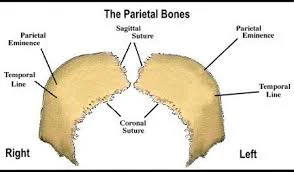The skull rests on the upper end of the vertebral column and
its bony structure is divided into two parts the cranium and the face.
The cranium is formed by a number of flat and irregular
bones that provide a bony protection for the brain .
It has a base upon which the brain rests and a vault that
surrounds and covers it.
The periosteum inside the skull bones consists of the outer
layer of dura mater.
The mature skull the joints (sutures) between the bones are
immovable (fibrous).
The bones have numerous perforations (e.g.foramina,fissures)
through which nerves,blood and lymph vessels.
1 frontal bone
2 parietal bones
2 temporal bones
1 occipital bone
1 sphenoid bone
1 ethmoid bone .
FRONTAL BONE :
This is the bone of the forehead.
It forms part of the orbital cavities(eye sockets)and the
prominent ridges above the eyes,the supra orbital margins.
Just above the supraorbital margins, within the bone, there
are two air-filled cavities or sinuses lined with ciliated mucous membrane
which have openings into the nasal cavity.
The coronal suture joins the frontal and parietal bones and
other fibrous joints are formed with the sphenoid ,zygomatic ,lacrimal,nasal
and ethmoid bones.
The bone orginates in two parts joined in the midline by the
frontal suture.
PARIETAL BONES:
Parietal bones articulate with each other at the sagittal
suture, with the frontal bone at the coronal suture, with the occipital bone at
the lamboidal suture and with the temporal bones at the squamous suture.
The inner surface is concave and is grooved by the brain and
blood vessels.
TEMPORAL BONES:
These bones lie on each side of the head and form immovable
joints with the parietal,occipital,sphenoid and zygomatic bones.
Each temporal bone has several important features.
The squamous part is the thin fan-shaped part that
articulates with the parietal bone.
The zygomatic process
articulates with the zygomatic arch(cheekbone).
The mastoid part contains the mastoid process, a thickened
region behind the ear.
It contains a large number of very small air sinuses which
communicate with the middle ear and are lined with squamous epithelium.
The petrous portion forms the part of the base of the skull and contains
the organs of hearing(the spiral organ) and balance.
The temporal bone articulates with the mandible at the
temporomandibular joint ,the only movable joint of the skull.
Immediately behind this articulating surface is the external
auditory meatus (auditory canal),which passes inwards towards the petrous
portion of the bone.
















0 Comments